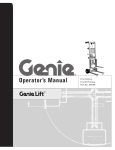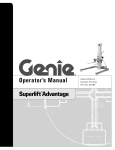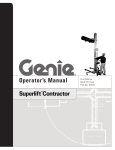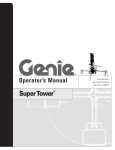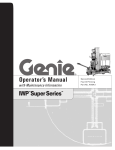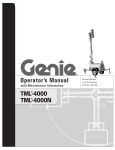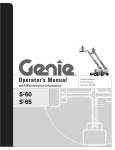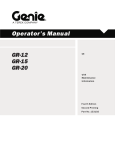Download Cables to Go 35566 Operator`s manual
Transcript
Operator's Manual First Edition • Seventh Printing Important Read, understand and obey these safety rules and operating instructions before operating this machine. Only trained and authorized personnel shall be permitted to operate this machine. If you have any questions, call Genie Industries. Contents Page Safety ......................................................................... 1 Legend ........................................................................ 6 Pre-operation Inspection ............................................. 8 Function Tests .......................................................... 10 Workplace Inspection ................................................ 13 Operating Instructions ............................................... 14 Battery & Charger Operating Instructions .................. 16 Transport Instructions ............................................... 17 Load Capacity Charts ................................................ 18 Decals ...................................................................... 20 Specifications ........................................................... 22 Copyright © 1995 by Genie Industries Contact us: Internet: http://www.genielift.com e-mail: [email protected] First Edition: Sixth Printing, December 2004 First Edition: Seventh Printing, August 2008 "Genie" is a registered trademark of Genie Industries in the USA and many other countries. Printed on recycled paper Printed in U.S.A. Genie Lift Part No. 35566 First Edition • Seventh Printing Operator's Manual Safety Rules Warning Failure to obey the instructions and safety rules in this manual may result in death or serious injury. Do Not Operate Unless: You learn and practice the principles of safe machine operation contained in this operator's manual. 1 Avoid hazardous situations. Know and understand the safety rules before going on to the next section. 2 Always perform a pre-operation inspection. 3 Always perform the function tests prior to use. 4 Inspect the workplace. 5 Only use the machine as it was intended. You read, understand and obey the manufacturer's instructions and safety rules— safety and operator's manuals and machine decals. You read, understand and obey employer's safety rules and work site regulations. You read, understand and obey all applicable governmental regulations. You are properly trained to safely operate the machine. Part No. 35566 Genie Lift 1 Operator's Manual First Edition • Seventh Printing SAFETY RULES Do not place ladders or scaffolding against any part of the machine. Fall Hazards Do not use as a personnel lifting platform or step. Do not operate the machine unless the wheel / leg / caster configuration is properly installed. Do not stand or sit on the forks, load platform or boom. Prior to use, check the work area for drop-offs, holes, bumps, debris, unstable or slippery surfaces or other possible hazardous conditions. Do not climb on the machine. Avoid debris and uneven surfaces while rolling a machine without the legs installed. Tip-over Hazards Do not exceed the rated load capacity. See Load Capacity Charts section. Do not raise the load unless the leg lock pins have been properly inserted into the legs. Do not raise the load unless the correct length legs are properly installed. Do not raise the load unless the machine is on a firm, level surface. Do not replace machine parts critical to stability or structure with items of different weight or specification. Do not cause a horizontal force or side load to the machine by raising or lowering a fixed or overhanging load. Do not use the machine on a moving or mobile surface or vehicle. Collision Hazards Do not raise if the load is not properly centered on the forks or load platform. Check the work area for overhead obstructions or other possible hazards. Do not move the machine with a raised load, except for minor positioning. Do not tilt the machine back with a raised load. Do not use blocks to level the machine. Do not operate the machine in strong or gusty winds. Increasing the load surface area will decrease machine stability in windy conditions. 2 Do not stand under or allow personnel under the machine when the load is raised. Do not lower the load unless the area below is clear of personnel and obstructions. Use common sense and planning when transporting the machine on an incline, slope or stairs. Maintain proper lubrication on the frame channels. See the Pre-operation Inspection section. Unlubricated frame channels can bind or stop moving, which could result in the load shifting or falling. Genie Lift Part No. 35566 First Edition • Seventh Printing Operator's Manual SAFETY RULES Electrocution Hazards Improper Use Hazard This machine is not electrically insulated and will not provide protection from contact with or proximity to electrical current. Never leave a machine unattended with a load. Unauthorized personnel may attempt to operate the machine without proper instruction, creating an unsafe condition. Maintain safe distances away from electrical power lines and apparatus in accordance with applicable governmental regulations and the following chart. Damaged Machine Hazards Do not use a damaged or malfunctioning machine. Voltage Minimum Safe Approach Distance Phase to Phase Feet 0 to 300V 300V to 50KV 50KV to 200KV 200KV to 350KV 350KV to 500KV 500KV to 750KV 750KV to 1000KV Avoid Contact 10 3.1 15 4.6 20 6.1 25 7.6 35 10.7 45 13.7 Meters Do not use a machine with less than 4 wraps of cable on the winch drum when the carriage is fully lowered. Conduct a thorough pre-operation inspection prior to each use. Allow for mast movement and electrical line sway or sag, and beware of strong or gusty winds. Keep away from the machine if it contacts energized power lines. Personnel must not touch or operate the machine until power lines are shut off. Do not use the machine as a ground for welding. Bodily Injury Hazards Do not grasp the cable. Keep hands and fingers away from the pulleys, carriage and other potential pinch points. Do not place arms, hands or fingers through the frame. Part No. 35566 Do not use a machine with a worn, frayed, kinked or damaged cable. Be sure that all decals are legible and in place. Maintain proper lubrication on the winch. See Genie Lift Parts and Service Manual for details. Do not allow oil or grease on braking surfaces. Crushing Hazard Maintain a firm grasp on the winch handle until the brake is locked. The brake is locked when the load will not cause the winch handle to turn. Lifting Hazard Use proper lifting techniques to load or tip the machine, or move the machine on stairs. Do not move the machine on stairs when the machine is equipped with the 4 point caster option. Genie Lift 3 Operator's Manual First Edition • Seventh Printing SAFETY RULES Ladder Safety Electric Winch Safety Fall Hazards Electrocution Hazard Do not use the ladder as scaffolding. Do not operate the DC battery charger unless using a 3-wire grounded extension cord connected to a grounded AC circit. Do not alter or disable the 3-wire grounded plugs. Do not sit on the ladder. Do not over reach. Keep your body centered between both side rails. Tip-over Hazards Do not use the top rung as a step. Do not exceed the rated load capacity. See Load Capacity Charts section. Tip-over Hazards Do not exceed the ladder's maximum capacity of 250 lbs / 113 kg. Do not use the electric winch on models with the standard base. The electric winch is designed for use only on straddle base models. Do not overload the ladder. Ladders are designed for 1 person only. Do not alter or disable the limit switch. Do not use the ladder unless it is properly set up. Battery and Charger Safety - Electric Winch Models Do not shift the ladder while on it. Avoid pushing or pulling off to the side of the ladder. Do not set up the ladder on slippery surfaces. Do not use blocks to level the ladder. Burn Hazards Batteries contain acid. Always wear protective clothing and eyewear when working with batteries. Avoid spilling or contacting battery acid. Neutralize battery acid spills with baking soda and water. The battery pack must remain in an upright position. 4 Genie Lift Part No. 35566 First Edition • Seventh Printing Operator's Manual SAFETY RULES Decal Legend Explosion Hazards Batteries emit explosive gas. Keep sparks, flames and lighted tobacco away from the battery. Genie product decals use symbols, color coding and signal words to identify the following: Charge the battery in a well-ventilated area. Do not disconnect the charger DC output wires from the battery when the charger is on. Electrocution Hazards Connect the charger to a grounded AC circuit only. Do not expose the battery or charger to water or rain. Before each use, inspect for damage. Replace damaged components before operating. Safety alert symbol—used to alert personnel to potential personal injury hazards. Obey all safety messages that follow this symbol to avoid possible injury or death. Red—used to indicate the presence of an imminently hazardous situation which, if not avoided, will result in death or serious injury. Orange—used to indicate the presence of a potentially hazardous situation which, if not avoided, could result in death or serious injury. Yellow with safety alert symbol— used to indicate the presence of a potentially hazardous situation which, if not avoided, may cause minor or moderate injury. Lifting Hazard The battery pack weighs 80 lbs / 37 kg. Use the appropriate number of people and proper lifting techniques when lifting the battery pack. Yellow without safety alert symbol—used to indicate the presence of a potentially hazardous situation which, if not avoided, may result in property damage. Green—used to indicate operation or maintenance information. Part No. 35566 Genie Lift 5 Operator's Manual First Edition • Seventh Printing Legend Standard Base with Standard Wheels Straddle Base with Pneumatic Wheels Counterweight Base 1 2 3 4 5 6 7 8 9 6 Handle Loading wheels Upper inner frame pulley Cable anchor Cable Inner frame Outer frame Decal plate Pneumatic wheel 10 11 12 13 14 15 16 Carriage Fork mounting tube Fork Adjustable leg - straddle base Lower inner frame pulley Leg lock pin Caster, 2 inch - option A Caster, 21/2 inch - option B Genie Lift 17 Wheel - 4 inch fixed 18 Adjustable leg - counterweight base 19 Caster - 5 inch swivel 20 Counterweight base 21 Caster - 2 inch dual wheel 22 Leg - standard base 23 Solid rubber wheel Part No. 35566 First Edition • Seventh Printing Operator's Manual LEGEND Models with electric winch option Straddle Base with 4 Point Casters 24 Brake (option) 25 Fork lock pin 26 Winch mounting bracket 27 Winch 28 Boom (option) 29 Load platform (option) 30 Electric winch battery Part No. 35566 31 32 33 34 35 36 Electric winch charger Electric winch (option) Electric winch control Electric winch limit switch Red Emergency Stop button Electric winch control up button Genie Lift 37 Electric winch control down button 38 Caster, 4 inch - option A Caster, 5 inch - option B 39 Ladder snap pin 40 Ladder (option) 7 Operator's Manual First Edition • Seventh Printing Pre-operation Inspection Fundamentals The pre-operation inspection is a visual inspection performed by the operator prior to each work shift. This inspection is designed to discover if anything is apparently wrong with a machine before the operator tests it. Do Not Operate Unless: You learn and practice the principles of safe machine operation contained in this operator's manual. 1 Avoid hazardous situations. 2 Always perform a pre-operation inspection. Know and understand the pre-operation inspection before going on to the next section. 3 Always perform function tests prior to use. 4 Inspect the workplace. 5 Only use the machine as it was intended. 8 Refer to the list on the next page and check each of the items. If damage or any unauthorized variation from factory delivered condition is discovered, the machine must be tagged and removed from service. Repairs to the machine may only be made by a qualified service technician, according to the manufacturer's specifications. After repairs are completed, the operator must perform a preoperation inspection again before testing the machine functions. Genie Lift Part No. 35566 First Edition • Seventh Printing Operator's Manual PRE-OPERATION INSPECTION Pre-operation Inspection R Be sure that the operator’s manual is complete, legible and available for reference. Check the entire machine for: R Be sure that all decals are legible and in place. See Decals section. R Corrosion or oxidation Check the following components or areas for damage, improperly installed or missing parts and unauthorized modifications: R Winch and related components R Base components R Legs R Roller wheels R Inner and outer frames R Glide buttons R Carriage hold-down assembly R Cable anchor R Dents or damage R Cracks in welds or structural components R Be sure that all structural and other critical components are present and all associated fasteners and pins are in place and properly tightened. R Inspect and clean the battery terminals and all battery cable connections. R Be sure there is a minimum of 4 wraps of cable around the winch drum when the carriage is fully lowered. R Be sure the frame channels are properly lubricated and free of debris. Lubricate the channels with a dry silicone spray or silicone wax (Genie part number 90337). R Cable and pulleys R Wheels and casters R Forks R Load platform and boom (if equipped) R Nuts, bolts and other fasteners R Cable (kinks, frays, abrasions) R Ladder (if equipped) R Brake system (if equipped) R Limit switch (electric winch models) R Electric winch and related components (if equipped) R Hand controls and wiring (electric winch models) Part No. 35566 Genie Lift 9 Operator's Manual First Edition • Seventh Printing Function Tests Fundamentals The function tests are designed to discover any malfunctions before the machine is put into service. The operator must follow the step-by-step instructions to test all machine functions. Do Not Operate Unless: You learn and practice the principles of safe machine operation contained in this operator's manual. 1 Avoid hazardous situations. 2 Always perform a pre-operation inspection. 3 Always perform function tests prior to use. A malfunctioning machine must never be used. If malfunctions are discovered, the machine must be tagged and removed from service. Repairs to the machine may only be made by a qualified service technician, according to the manufacturer's specifications. After repairs are completed, the operator must perform a pre-operation inspection and function tests again before putting the machine into service. Know and understand the function tests before going on to the next section. 4 Inspect the workplace. 5 Only use the machine as it was intended. 10 Genie Lift Part No. 35566 First Edition • Seventh Printing Operator's Manual FUNCTION TESTS Function Tests Load Platform 1 Select a test area that is firm, level and free of obstructions. 1 Lay the load platform onto the forks. Setup 1 Tilt the machine back. 2 Slide each fork onto the carriage and secure it with the fork lock pins. 3 Slide each leg into a base socket until the leg lock pin snaps into the leg. 2 Lift the front of the load platform and push it toward the carriage until the back angle is under the lower fork mounting tube. 3 Rotate the load platform down until it locks into place over the forks. Ladder Setup (if equipped) 1 Position the machine. 2 Pull the snap pins on both sides of the ladder. 3 Pull the ladder down into the lowered position. Be sure to support the ladder until it is fully lowered. 4 Stand the machine up. 5 Remove the winch handle, reverse the handle and install it. The handle grip should face the operator. To store the ladder: Raise the ladder to the stowed position and be sure the snap pins lock into place. 6 Straddle base: Adjust to desired width. Be sure the leg lock pin snaps into the leg. 7 Rotate the hold-down bar off of the carriage. Boom 1 Hold the boom in a vertical position. 2 Place the top of the boom plate under the upper fork mounting tube and lift up. 3 Rotate the boom down until it locks into place. 4 Attach the lifting shackle to the desired hole on the boom. Part No. 35566 Genie Lift 11 Operator's Manual First Edition • Seventh Printing FUNCTION TESTS Test the Brake Operation (if equipped) Test Electric Winch Operation (if equipped) 1 Press down on the foot pedal to lock the brake. Note: The Genie Lift 4 does not have an inner frame. 2 Push the machine. Result: The wheels should not roll. 1 Connect the battery pack. 2 Pull out the red Emergency Stop button to the on position. 3 Pull up on the foot pedal to release the brake. 4 Push the machine. 3 Push the up button on the hand controls. Result: The machine should move. Result: The carriage should raise to the top of the inner frame and then the inner frame should raise. The carriage and inner frame should move smoothly, free of hesitation and binding. The winch should turn off when the carriage reaches maximum height. Test the Winch Operation Note: The Genie Lift 4 does not have an inner frame. 1 Rotate the winch handle clockwise to raise the carriage. Result: The carriage should raise to the top of the inner frame and then the inner frame should raise. The carriage and inner frame should move smoothly, free of hesitation and binding. 4 Push in the red Emergency Stop button to the off position. 5 Push the down button, then the up button. 2 Rotate the winch handle counterclockwise to lower the carriage. Result: The up/down function should not operate. Result: The inner frame should lower into the outer frame, and then the carriage should lower into the inner frame. The carriage and inner frame should move smoothly, free of hesitation and binding. Note: If the carriage and inner frame do not move freely, the channels may need to be lubricated with a dry silicone spray or silicone wax. 12 Genie Lift Part No. 35566 First Edition • Seventh Printing Operator's Manual Workplace Inspection Be aware of and avoid the following hazardous situations: · drop-offs or holes · bumps and floor obstructions · debris · overhead obstructions and high voltage conductors Do Not Operate Unless: You learn and practice the principles of safe machine operation contained in this operator's manual. 1 Avoid hazardous situations. · hazardous locations · sloped surfaces · unstable or slippery surfaces 2 Always perform a pre-operation inspection. · inadequate surface support to withstand all load forces imposed by the machine 3 Always perform function tests prior to use. · wind and weather conditions 4 Inspect the workplace. · all other possible unsafe conditions Know and understand the workplace inspection before going on to the next section. 5 Only use the machine as it was intended. Fundamentals The workplace inspection helps the operator determine if the workplace is suitable for safe machine operation. It should be performed by the operator prior to moving the machine to the workplace. It is the operator's responsibility to read and remember the workplace hazards, then watch for and avoid them while moving, setting up and operating the machine. Part No. 35566 Genie Lift 13 Operator's Manual First Edition • Seventh Printing Operating Instructions Setup Select an area that is firm, level and free of obstructions. Follow the Setup procedures in the Function Tests section. Do Not Operate Unless: You learn and practice the principles of safe machine operation contained in this operator's manual. Raising and Lowering Load Manual Winch 1 Center the load on the forks or load platform. 2 Raise the load by firmly grasping the winch handle and rotating it clockwise. Do not allow the cable to wind unevenly onto the winch drum. 1 Avoid hazardous situations. 2 Always perform a pre-operation inspection. 3 Always perform function tests prior to use. 5 Only use the machine as it was intended. 3 Lower the load by firmly grasping the winch handle and rotating it counterclockwise. After lowering to the desired position, turn the winch handle clockwise (raise the load) 1/4 turn to set the brake. Fundamentals Raising and Lowering Load Electric Winch 4 Inspect the workplace. The Operating Instructions section provides instructions for each aspect of machine operation. It is the operator's responsibility to follow all the safety rules and instructions in the operator's manual. 1 Center the load on the forks or load platform. Using the machine for any purpose other than lifting material is unsafe. 4 Push the up or down button on the hand controls for the desired direction of travel. 2 Connect the battery pack. 3 Pull out the red Emergency Stop button to the on position. If more than one operator is expected to use a machine at different times in the same work shift, each operator is expected to follow all safety rules and instructions in the operator's manual. That means every new operator should perform a preoperation inspection, function tests and a workplace inspection before using the machine. 14 Genie Lift Part No. 35566 First Edition • Seventh Printing Operator's Manual OPERATING INSTRUCTIONS Moving Machine with a Load After Each Use It is best to move the machine on the work site with no load. Moving a raised load should be restricted to positioning for loading and unloading. If it is necessary to move the machine with a raised load, understand and obey the following safety rules: To prepare the machine for storage, remove the forks and legs and reverse the winch handle. Refer to the Setup procedure. · Make sure the area is level and clear of obstructions. Select a safe storage location - firm level surface, weather protected, clear of obstruction and traffic. Models with electric winch: Recharge the battery. · Make sure the load is centered on the forks or load platform. · Avoid sudden starts and stops. · Travel with the load in the lowest possible position. · Keep personnel away from the machine and load. · Do not tilt the machine back with a raised load. Moving Machine on Stairs It is best to move the machine on stairs using the optional stair glides. Moving the machine on stairs without the use of stair glides is not recommended. If it is necessary to move the machine on stairs, understand and obey the following safety rules: · Do not move the machine on stairs when the machine is equipped with the 4 point caster option. · Fully lower the load. · Ease the machine over each stair. Maintain a firm grasp on the handle. · Do not allow the machine to become unbalanced. · Continue carefully up or down the stairs. · Use the appropriate number of people and proper lifting techniques with heavy loads. · Models with electric winch: Remove the battery pack. Part No. 35566 Genie Lift 15 Operator's Manual First Edition • Seventh Printing OPERATING INSTRUCTIONS 9 Charger models equipped with manual/auto selector switch: If the ampere meter indicates that the battery is not being charged, set the power switch to the MANUAL position until the ampere meter begins to move up the scale. Then set the power switch to the AUTO position. Battery and Charger Instructions Observe and Obey: 10 The charger will turn off automatically when the battery is fully charged. If equipped: Set the power switch to the OFF position, then disconnect from the AC supply. 11 Check the battery acid level when the charge cycle is complete. Replenish with distilled water to the bottom of the fill tube. Do not overfill. Do not use an external charger or booster battery. Charge the battery in a well-ventilated area. Use proper AC input voltage for charging as indicated on the charger. Dry Battery Filling and Charging Instructions Use only a Genie authorized battery and charger. To Charge Battery 1 Open the battery pack lid to access the battery. 1 Remove the battery vent caps and permanently remove the plastic seal from the battery vent openings. 2 Fill each cell with battery acid (electrolyte) until the level is sufficient to cover the plates. 2 Remove the battery vent caps and check the battery acid level. If necessary, add only enough distilled water to cover the plates. Do not overfill prior to the charge cycle. Do not fill to maximum level until the battery charge cycle is complete. Overfilling can cause the battery acid to overflow during charging. Neutralize battery acid spills with baking soda and water. 3 Replace the battery vent caps. 4 If equipped: Set the power switch to the OFF position. Be sure that the DC output cord is properly connected to the battery (black to negative, red to positive). 3 Install the battery vent caps. 4 Charge the battery. 5 Connect the battery charger to a grounded AC circuit. 5 Check the battery acid level when the charging cycle is complete. Replenish with distilled water to the bottom of the fill tube. Do not overfill. 6 If equipped: Set the AC Selector switch to the proper voltage. 7 Set the power switch to the AUTO position. 8 Monitor the ampere meter for the correct charge rate. The initial charge rate should be approximately 10A. The charge rate will decrease as the battery reaches full charge. 16 Genie Lift Part No. 35566 First Edition • Seventh Printing Operator's Manual OPERATING INSTRUCTIONS Lifting Instructions The number of people required to load and unload a machine is dependent on a number of factors, including but not limited to: · the physical condition, strength and disabilities or prior injuries of the people involved Transport Instructions · the vertical and horizontal distances the machine has to be moved Observe and Obey: Be sure the vehicle capacity and loading surfaces are sufficient to support the machine weight. See the serial plate for the machine weight. · the number of times the machine will be loaded or unloaded · the stance, posture and grip used by the people involved The transport vehicle must be parked on a level surface. · the lifting techniques used Remove the load from the forks, boom or load platform before loading for transport. The transport vehicle must be secured to prevent rolling while the machine is being loaded. The machine must be securely fastened to the transport vehicle. · the site conditions and weather in which the activity is being performed (i.e., slippery, icy, raining) The appropriate number of people and proper lifting techniques must be used to prevent physical injury. Loading for Transport 1 Fully lower the carriage. 2 Rotate the carriage hold-down bar over the carriage. Be sure the lock pin snaps into place. 3 Remove the winch handle, reverse the handle and install it. The handle grip should face the carriage. 4 Models with electric winch: Remove the battery pack. Part No. 35566 Genie Lift 17 Operator's Manual First Edition • Seventh Printing Load Capacity Charts Forks Load Positioning Instructions 1 Determine the weight of the load and the location of its load center. 2 Measure to the load center from the side of the load that will be closest to the carriage. Observe and Obey: Failure to properly position the load may result in death or serious injury. 3 Refer to the chart on the next page to determine if the machine is capable of lifting the weight at the location on the forks. Verify that the load you wish to raise does not exceed the maximum load for your load center. See the load capacity charts on the next page. 4 Place the load so that it rests on the forks, as close to the carriage as possible. Tip-over hazard. Raising a load that exceeds the machine capacity may result in death or serious injury. 5 Position the load so that the load center is within the load center zone. A load center is defined as the balancing point (center of gravity) of a load and must be positioned within the load center zone. Tip-over hazard. Failure to position the load center within the load center zone may result in death or serious injury. 18 Genie Lift measure to the load center Load Center Zone Part No. 35566 First Edition • Seventh Printing Operator's Manual LOAD CAPACITY CHARTS Maximum Load Centers Forks Load Capacity Chart inches cm 12 30 14 35 GL-4 lbs kg GL-8 lbs kg lbs kg lbs kg 500 227 400 181 350 159 500 227 400 181 350 159 350 159 350 159 (measure from front of carriage) Model GL-10 GL-12 Forks: 14 in 35 cm Load Platform: 14 in 35 cm Boom: 20 in 51 cm Boom Load Positioning Instructions 1 Determine the weight of the load and the location of its load center. 2 Refer to the chart below to determine if the machine is capable of lifting the weight at the location on the boom. 3 Attach the lifting shackle to the desired hole on the boom. Boom Load Capacity Chart Model Rear mounting hole Front mounting hole Part No. 35566 Front Hole Rear Hole GL-4 lbs kg 300 136 500 227 GL-8 lbs kg 240 109 400 181 GL-10 lbs kg 210 95 350 159 GL-12 lbs kg 210 95 350 159 Genie Lift 19 Operator's Manual First Edition • Seventh Printing Decals Inspection for Decals with Words Part No. Description Determine whether the decals on your machine have words or symbols. Use the appropriate inspection to verify that all decals are legible and in place. 35579 Notice - Max Capacity 500 lbs / 227 kg, GL-4 1 37049 Warning - Tip-over Hazard 1 Part No. Description Quantity 37084 Notice - Load Platform Setup 1 Quantity 37111 Warning - Ladder Safety and Setup 1 33468 Warning - No Riders 1 37120 Warning - No Step 1 35567 Warning - Bodily Injury Hazard 1 43021 Warning/Notice - Electric Winch Safety 1 35574 Warning - Machine Safety and Setup 1 43022 35575 Notice - Boom Setup 1 Danger/Notice - Electric Winch Battery Safety 1 35577 Notice - Max Capacity 350 lbs / 159 kg, GL-10, GL-12 52982 Cosmetic - Genie Lift 1 1 82959 Danger - Electrocution Hazard 1 Notice - Max Capacity 400 lbs / 181 kg, GL-8 1 97529 Caution - Bodily Injury Hazard 1 35578 35574 35567 43022 43021 52982 35577 or 35578 or 35579 35577 or 35578 or 35579 37120 37111 82959 33468 97529 37111 Serial Plate 37084 37049 Shading indicates decal is hidden from view, i.e., under covers. 20 Genie Lift 35575 Part No. 35566 First Edition • Seventh Printing Operator's Manual DECALS Inspection for Decals with Symbols Part No. Description 97510 Warning - Boom Setup 1 Determine whether the decals on your machine have words or symbols. Use the appropriate inspection to verify that all decals are legible and in place. 97511 Warning - Max Capacity 159 kg, GL-10, GL-12 1 97512 Warning - Max Capacity 181 kg, GL-8 1 97513 Warning - Max Capacity 227 kg, GL-4 1 Quantity 97532 Caution - Bodily Injury Hazard 1 Part No. Description Quantity 52982 Cosmetic - Genie Lift 1 97533 Warning - No Step 2 82481 Danger - Battery Safety 1 97536 Warning - Do Not Reach 1 82962 Warning - No Riders 1 97539 Danger - Electrocution Hazard 2 82487 Label - Read the Manual 3 97540 Warning - Ladder Capacity, 113 kg 2 52982 97539 97536 82487 82487 82481 97511 or 97512 or 97513 97511 or 97512 or 97513 97533 97540 97539 97532 97540 82962 Serial Plate 82487 Shading indicates decal is hidden from view, i.e., under covers. Part No. 35566 Genie Lift 82487 97510 21 Operator's Manual First Edition • Seventh Printing Specifications Model GL-4 GL-8 GL-10 GL-12 Height, maximum lift Forks up 5 ft 11 in 1.8 m 10 ft 1/2 in 3.06 m 11 ft 8 in 3.6 m 13 ft 91/2 in 4.2 m Height, maximum lift Forks down 4 ft 11/2 in 1.2 m 8 ft 3 in 2.5 m 9 ft 101/2 in 3m 12 ft 3.7 m 31/2 in 8.9 cm 31/2 in 8.9 cm 2 in 5.1 cm 2 in 5.1 cm 500 lbs 227 kg 400 lbs 181 kg 350 lbs 159 kg 350 lbs 159 kg 6 ft 51/2 in 2m 7 ft 63/4 in 2.3 m Height, minimum lift Forks down Lift capacity at 12 in / 30.5 cm load center Machine weight Height, stowed* Ground clearance* See specification chart on next page. 5 ft 71/2 in 1.7 m 3/4 5 ft 71/2 in 1.7 m 3 /4 3 /4 3/4 in 1.9 cm in 1.9 cm in 1.9 cm in 1.9 cm 243/4 in 62.9 cm 243/4 in 62.9 cm NA NA Length - stowed 12 in 30.5 cm 12 in 30.5 cm NA NA Length - operating 343/4 in 88.3 cm 343/4 in 88.3 cm NA NA 283/4 in 73 cm 283/4 in 73 cm 283/4 in 73 cm 283/4 in 73 cm Width - extended 431/2 in 1.1 m 431/2 in 1.1 m 431/2 in 1.1 m 431/2 in 1.1 m Length - stowed 191/4 in 48.9 cm 191/4 in 48.9 cm 191/4 in 48.9 cm 191/4 in 48.9 cm 43 in 1m 43 in 1m 43 in 1m 43 in 1m 283/4 in 73 cm 283/4 in 73 cm 283/4 in 73 cm NA Width - extended 431/2 in 1.1 m 431/2 in 1.1 m 431/2 in 1.1 m NA Length - operating 281/2 in 72.4 cm 281/2 in 72.4 cm 281/2 in 72.4 cm NA 90 dB 95 dB 90 dB 95 dB Standard base Width Straddle base Width - stowed Length - operating Counterweighted base Width - stowed Airborne noise emissions by machinery Maximum sound level at normal operating workstations (A-weighted) Manual winch 90 dB 90 dB Electric winch 95 dB 95 dB * The 10 inch pneumatic rear wheel option will add 1 inch / 2.5 cm to these specifications. * The 4 point caster option B will add 1 inch / 2.5 cm to these specifications. * The counterweight base will add 1 inch / 2.5 cm to these specifications. 22 Genie Lift Part No. 35566 First Edition • Seventh Printing Operator's Manual SPECIFICATIONS Model Forks Length Width Load Platform Length Width GL-4 GL-8 GL-10 GL-12 221/2 in 57.2 cm 201/2 in 52.1 cm 221/2 in 57.2 cm 201/2 in 52.1 cm 221/2 in 57.2 cm 201/2 in 52.1 cm 221/2 in 57.2 cm 201/2 in 52.1 cm 23 in 58.4 cm 22 in 55.9 cm 23 in 58.4 cm 22 in 55.9 cm 23 in 58.4 cm 22 in 55.9 cm 23 in 58.4 cm 22 in 55.9 cm Machine Configurations Machine Weights Base: Standard Base GL-4 and GL-8 Genie Lift 4 Base: Standard Standard Straddle Straddle Straddle Straddle Counterweight Caster Option: Standard Pneumatic Standard Pneumatic 4 point caster A 4 point caster B Standard Weight: 113 lbs / 51 kg 117 lbs / 53 kg 126 lbs / 57 kg 130 lbs / 59 kg 137 lbs / 62 kg 139 lbs / 63 kg 392 lbs / 178 kg Genie Lift 8 Base: Standard Standard Straddle Straddle Straddle Straddle Counterweight Caster Option: Standard Pneumatic Standard Pneumatic 4 point caster A 4 point caster B Standard Weight: 132 lbs / 60 kg 136 lbs / 62 kg 145 lbs / 66 kg 149 lbs / 68 kg 156 lbs / 71 kg 158 lbs / 72 kg 411 lbs / 186 kg 21/2 inch swivel casters 5 inch swivel casters with side brakes and 4 point rotational locks Genie Lift 10 Base: Straddle Straddle Straddle Straddle Counterweight Caster Option: Standard Pneumatic 4 point caster A 4 point caster B Standard Weight: 149 lbs / 68 kg 153 lbs / 69 kg 160 lbs / 73 kg 162 lbs / 73 kg 415 lbs / 188 kg 4 inch fixed wheel 5 inch swivel casters with side brakes Genie Lift 12 Base: Straddle Straddle Straddle Straddle Caster Option: Standard Pneumatic 4 point caster A 4 point caster B Weight: 154 lbs / 70 kg 158 lbs / 72 kg 165 lbs / 75 kg 167 lbs / 76 kg *Wheel and Casters: Pneumatic option Front: Rear: 21/2 inch swivel casters 10 inch pneumatic wheels Base: Straddle Base GL-4, GL-8, GL-10 and GL-12 *Wheel and Casters: Pneumatic option Front: Rear: 4 point caster option A Front: Rear: 4 point caster option B Front: Rear: 21/2 inch swivel casters 10 inch pneumatic wheels 2 inch dual wheel swivel casters 4 inch swivel casters Base: Counterweight GL-4, GL-8, GL-10 **Wheel and Casters: Front: Rear: *Machines with standard or straddle base ship standard with 8 inch rear wheels and 2 inch dual wheel front swivel casters. **Machines with counterweight base ship standard with 5 inch rear swivel casters with side brakes and 4 inch front fixed wheels. Part No. 35566 The electric winch option will add an additional 103 lbs / 47 kg to the above machine weights. Genie Lift 23

























